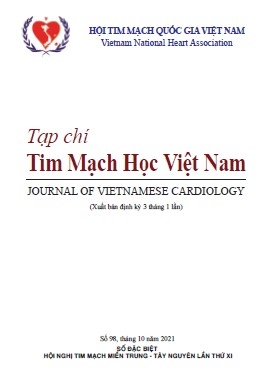Đột quỵ sau can thiệp mạch vành – kinh nghiệm qua ca lâm sàng
DOI:
https://doi.org/10.58354/jvc.98.2021.111Tóm tắt
Đặt vấn đề: Đột quỵ thiếu máu não xảy ra sau can thiệp động mạch vành qua da (PCI) tiên phát thường là hiếm nhưng để lại hậu quả nặng nề. Tỷ lệ bệnh nặng và tử vong nội viện ở nhóm bệnh nhân này cao hơn so với nhóm bệnh nhân bị các biến chứng khác liên quan đến thủ thuật.
Đối tượng và phương pháp nghiên cứu: Nghiên cứu nhân một trường hợp bị biến chứng đột quỵ thiếu máu não cấp sau can thiệp mạch vành cấp cứu.
Kết quả: Chẩn đoán bệnh nhân bị đột quỵ ngay lúc bệnh nhân còn nằm trên bàn thủ thuật rất quan trọng. Người làm thủ thuật nên kiểm tra tình trạng của bệnh nhân sau những bước chính của quy trình can thiệp như hút huyết khối. Nếu nghi ngờ đột quỵ thiếu máu não khi ống thông động mạch đùi vẫn còn trong lòng mạch, tiến hành chụp mạch não ngay là một giải pháp khả dĩ được thực hiện bởi bác sỹ can thiệp để xác nhận chẩn đoán và xác định hình thái của huyết khối, mức độ thuyên tắc. Lấy huyết khối cơ học và thuốc ly giải huyết khối động mạch như alteplase có thể là giải pháp điều trị chọn lựa trong tình huống này.
Kết luận: Nên tránh hút huyết khối thường quy và thực hiện cẩn trọng có thể giúp chúng ta ngăn ngừa biến chứng đột quỵ nhồi máu não cấp. Nhận diện sớm triệu chứng nghi ngờ ngay sau khi hoàn tất thủ thuật cũng như trong quá trình theo dõi để đánh giá chính xác thời gian cửa sổ điều trị và phối hợp nhiều nhóm chuyên khoa.
Từ khóa: Đột quỵ, can thiệp động mạch vành qua da.
Tài liệu tham khảo
1. Bộ Y tế Việt Nam (2019). Hướng dẫn chẩn đoán và xử trí hội chứng mạch vành cấp.
![]()
2. Budaj,Andrzejvàcộngsự. (2005). “Magnitude of and risk factors for in-hospital and postdischarge stroke in patients with acute coronary syndromes: findings from a Global Registry of Acute Coronary Events”, Circulation. 111(24), tr. 3242-3247.
![]()
3. Dawson, Luke P và cộng sự. (2020). “Incidence and risk factors for stroke following percutaneous coronary intervention”, International Journal of Stroke. 15(8), tr. 909-922.
![]()
4. Fuchs, Shmuel và cộng sự. (2002). “Stroke complicating percutaneous coronary interventions: incidence, predictors, and prognostic implications”, Circulation. 106(1), tr. 86-91.
![]()
5. Hoffman,ScottJvàcộngsự.(2012).“Procedural factors associated with percutaneous coronary intervention-related ischemic stroke”, JACC: Cardiovascular Interventions. 5(2), tr. 200-206.
![]()
6. Ibanez, Borja và cộng sự. (2018). “2017 ESC Guidelines for the management of acute myocardial infarction in patients presenting with ST-segment elevation: The Task Force for the management of acute myocardial infarction in patients presenting with ST-segment elevation of the European Society of Cardiology (ESC)”, European heart journal. 39(2), tr. 119-177.
![]()
7. Jassal, Davinder S, Fast, Mallory D và McGinn, Gregory (2000). “Multifocal brain MRI hypointensities secondary to cardiac catheterization”, Neurology. 54(10), tr. 2023-2024.
![]()
8. Jolly, Sanjit S và cộng sự (2016). “Outcomes after thrombus aspiration for ST elevation myocardial infarction: 1-year follow-up of the prospective randomised TOTAL trial”. 387(10014), tr. 127-135.
![]()
9. Kawamura, Akio và cộng sự. (2007). “Stroke complicating percutaneous coronary intervention in patients with acute myocardial infarction”, Circulation Journal. 71(9), tr. 1370-1375.
![]()
10. Keeley, EllenC và Grines, Cindy L (1998). “Scraping of aortic debris by coronary guiding catheters: a prospective evaluation of 1,000 cases”, Journal of the American College of Cardiology. 32(7), tr. 1861-1865.
![]()
11. Korn‐Lubetzki, Isabelle và cộng sự (2013). “Incidence and risk factors of cerebrovascular events following cardiac catheterization”, Journal of the American Heart Association. 2(6), tr. e000413.
![]()
12. Kwok, Chun Shing và cộng sự (2015). “Stroke following percutaneous coronary intervention: type-specific incidence, outcomes and determinants seen by the British Cardiovascular Intervention Society 2007–12”, European heart journal. 36(25), tr. 1618-1628.
![]()
13. Lagerqvist, Bo và cộng sự (2014). “Outcomes 1 year after thrombus aspiration for myocardial infarction”, New England Journal of Medicine. 371(12), tr. 1111-1120.
![]()
14. Myint, Phyo Kyaw và cộng sự (2016). “Determinants and outcomes of stroke following percutaneous coronary intervention by indication”, Stroke. 47(6), tr. 1500-1507.
![]()
15. Patel, Vishal G và cộng sự (2013). “Meta-analysis of stroke after transradial versus transfemoral artery catheterization”, International journal of cardiology. 168(6), tr. 5234-5238.
![]()
16. Svilaas, Tone và cộng sự (2008). “Thrombus aspiration during primary percutaneous coronary intervention”, New England journal of medicine. 358(6), tr. 557-567.
![]()
17. Taylor,RobertAvàcộngsự(2021).“Stroke after cardiac catheterization”, Uptodate. Available from https://www.uptodate.com/ contents/stroke-after-cardiac-catheterization?search=stroke%20after% 20car- diac%20catheterization&source=search_result&selectedTitle=1~150&usage_type=default&display_ rank=1#H5651069.
https://www.uptodate.com/ contents/stroke-after-cardiac-catheterization?search=stroke%20after% 20car- diac%20catheterization&source=search_result&selectedTitle=1~150&usage_type=default&display_ rank=1#H5651069.">
![]()
18. Werner, Nicolas và cộng sự (2013). “Incidence and clinical impact of stroke complicating percutaneous coronary intervention: results of the Euro heart survey percutaneous coronary interventions registry”, Circulation: Cardiovascular Interventions. 6(4), tr. 362-369.
![]()
19. Werner, Nicolas, Zahn, Ralf và Zeymer, Uwe (2012). “Stroke in patients undergoing coronary angiography and percutaneous coronary intervention: incidence, predictors, outcome and therapeutic options”, Expert review of cardiovascular therapy. 10(10), tr. 1297-1305.
![]()
20.Wijman, Christine AC và cộng sự (1998). “Cerebral air embolism as a cause of stroke during cardiac catherization”, Neurology. 51(1), tr. 318-319.
![]()
Tải xuống
Đã Xuất bản
Các phiên bản
- 03-03-2023 (2)
- 03-03-2023 (1)








